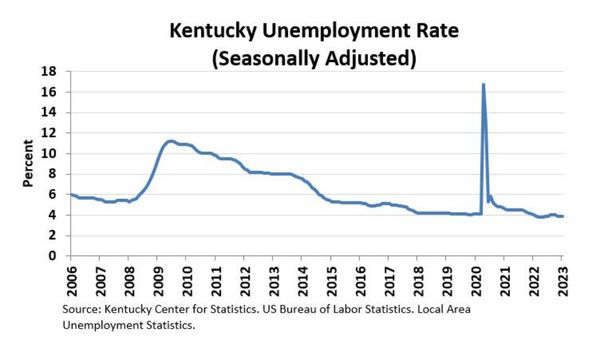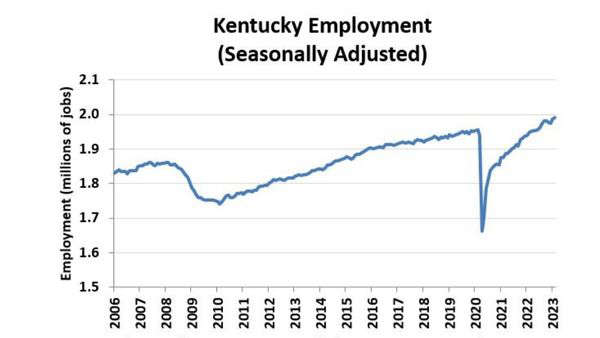Feb jobless rate remained unchanged

FRANKFORT, Ky. (March 23, 2023) — Kentucky’s seasonally adjusted preliminary February 2023 unemployment rate was 3.9%, according to the Kentucky Center for Statistics (KYSTATS), an agency within the Kentucky Education and Labor Cabinet (KELC).
The preliminary February 2023 jobless rate was unchanged from January 2023 and unchanged from the 3.9% recorded for the state one year ago.
The U.S. seasonally adjusted jobless rate for February 2023 was 3.6%, which was up 0.2 percentage points from January 2023, according to the U.S. Department of Labor.
Labor force statistics, including the unemployment rate, are based upon estimates from the Current Population Survey of households. The survey is designed to measure trends in the number of people working and includes jobs in agriculture and individuals who are self-employed.
Kentucky’s civilian labor force was 2,041,610 in February 2023, an increase of 1,043 individuals from January 2023. The number of people employed in February rose by 414 to 1,961,962 while the number of unemployed increased by 629 to 79,648.
“Kentucky’s unemployment rate held steady at 3.9% in February as there was little change in the state’s labor market,” said University of Kentucky’s Center for Business and Economic Research (CBER) Director Mike Clark, Ph.D.
In a separate federal survey of business establishments that excludes jobs in agriculture and people who are self-employed, Kentucky’s seasonally adjusted nonfarm employment increased by 6,200 jobs in February 2023 compared to January 2023. Kentucky’s nonfarm employment was up 43,000 jobs or 2.2% compared to February 2022.
“The latest estimates from employers suggest that the number of jobs in Kentucky continued to increase in February,” said Clark. “An increase in the estimated number of government jobs offset a decline in the number of private sector jobs.”
Nonfarm data is provided by the Bureau of Labor Statistics’ Current Employment Statistics program. According to the survey, employment increased for four of Kentucky’s major nonfarm North American Industry Classification System (NAICS) job sectors in February 2023, decreased for six, and was unchanged for one.
Government sector employment jumped by 6,900 jobs from January 2023 to February 2023. Employment was down 200 jobs in the federal government; up 6,300 positions in state government; and up 800 jobs in local government. Employment in the total government sector rose by 8,300 positions or 2.8% compared to February 2022.
“The preliminary estimates indicate that state government employment jumped by 7.2% in February,” said Clark. “This represents a significant increase and reverses a downward trend for government employment. However, preliminary estimates should be interpreted with caution as they are often revised as more information becomes available.”
Employment in Kentucky’s professional and business services sector added 1,500 jobs or 0.7% in February 2023. The professional, scientific and technical services subsector lost 500 from January to February. Employment in the management of companies subsector was unchanged. The administrative, support and waste management subsector added 2,000 jobs. Employment in this sector increased by 2,600 jobs or 1.1% since February 2022.
Kentucky’s educational and health services sector gained 700 positions in February 2023. Employment in the health care and social assistance subsector added 500 jobs in February while the educational services subsector rose by 200 jobs. Since last February, this sector has grown by 9,800 jobs or 3.4%.
The financial activities sector added 300 jobs from January 2023 to February 2023. Employment increased by 100 jobs in the finance and insurance subsector from January to February and by 200 jobs in the real estate, rental and leasing subsector. The financial activities sector decreased by 800 jobs compared to last February.
Employment in Kentucky’s mining and logging sector was unchanged in February. This sector was up 500 jobs from February 2022.
Employment in the information services sector decreased by 200 jobs in February. The industries in this sector include traditional publishing as well as software publishing; motion pictures and broadcasting; and telecommunications. The number of jobs in this sector grew by 1,100 or 5.2% from one year ago.
The other services sector lost 200 jobs in February 2023. This sector had 1,900 more positions compared to February 2022. This sector includes repairs and maintenance, personal care services and religious organizations.
Construction employment declined by 300 jobs in February 2023 or 0.4% from January and was up 500 positions or 0.6% from one year ago.
Kentucky’s leisure and hospitality sector fell by 700 positions from January 2023 to February 2023, a loss of 0.4%. This sector added 4,300 jobs, or 2.2%, compared to February 2022. Employment in the arts, entertainment and recreation subsector increased by 100 jobs from January to February. The accommodations and food services subsector lost 800 jobs in February.
Employment in Kentucky’s manufacturing sector dropped by 700 jobs from January 2023 to February 2023. Durable goods manufacturing employment was up 200 jobs in February. Non-durable goods manufacturers lost 900 jobs. Kentucky’s manufacturing employment was up 8,400 positions or 3.4% since February 2022.
Employment in Kentucky’s trade, transportation and utilities sector fell by 1,100 jobs from January to February. Employment was up 6,400 jobs or 1.5% compared to a year ago. The retail trade subsector lost 1,700 jobs from January to February. Employment was up 500 positions in the wholesale trade subsector and was also up 100 jobs in the transportation, warehousing and utilities subsector.
Civilian labor force statistics include nonmilitary workers and unemployed Kentuckians who are actively seeking work. They do not include unemployed Kentuckians who have not looked for employment within the past four weeks.
Kentucky’s statewide unemployment rate and employment levels are seasonally adjusted. Employment statistics undergo sharp fluctuations due to seasonal events, such as weather changes, harvests, holidays, and school openings and closings. Seasonal adjustments eliminate these influences and make it easier to observe statistical trends. However, due to the small sample size, county unemployment rates are not seasonally adjusted.


 Community Foundation of Madison & Jefferson County, Inc. Receives National Recognition
Community Foundation of Madison & Jefferson County, Inc. Receives National Recognition
 MADISON MAN SENTENCED TO 30 YEARS FOR JEFFERSON COUNTY’S FIRST DEALING RESULTING IN DEATH CONVICTION
MADISON MAN SENTENCED TO 30 YEARS FOR JEFFERSON COUNTY’S FIRST DEALING RESULTING IN DEATH CONVICTION
 MADISON WOMAN SENTENCED TO 25 YEARS FOR ROLE IN DRUG ENTERPRISE
MADISON WOMAN SENTENCED TO 25 YEARS FOR ROLE IN DRUG ENTERPRISE







